Used in this demonstration: Lipavi C20 container, N20 polycarbonate rack. Lipavi C20L lid.

Above: the whole brisket, approximately 14 lbs/6 Kg. The point is shown at the far left.
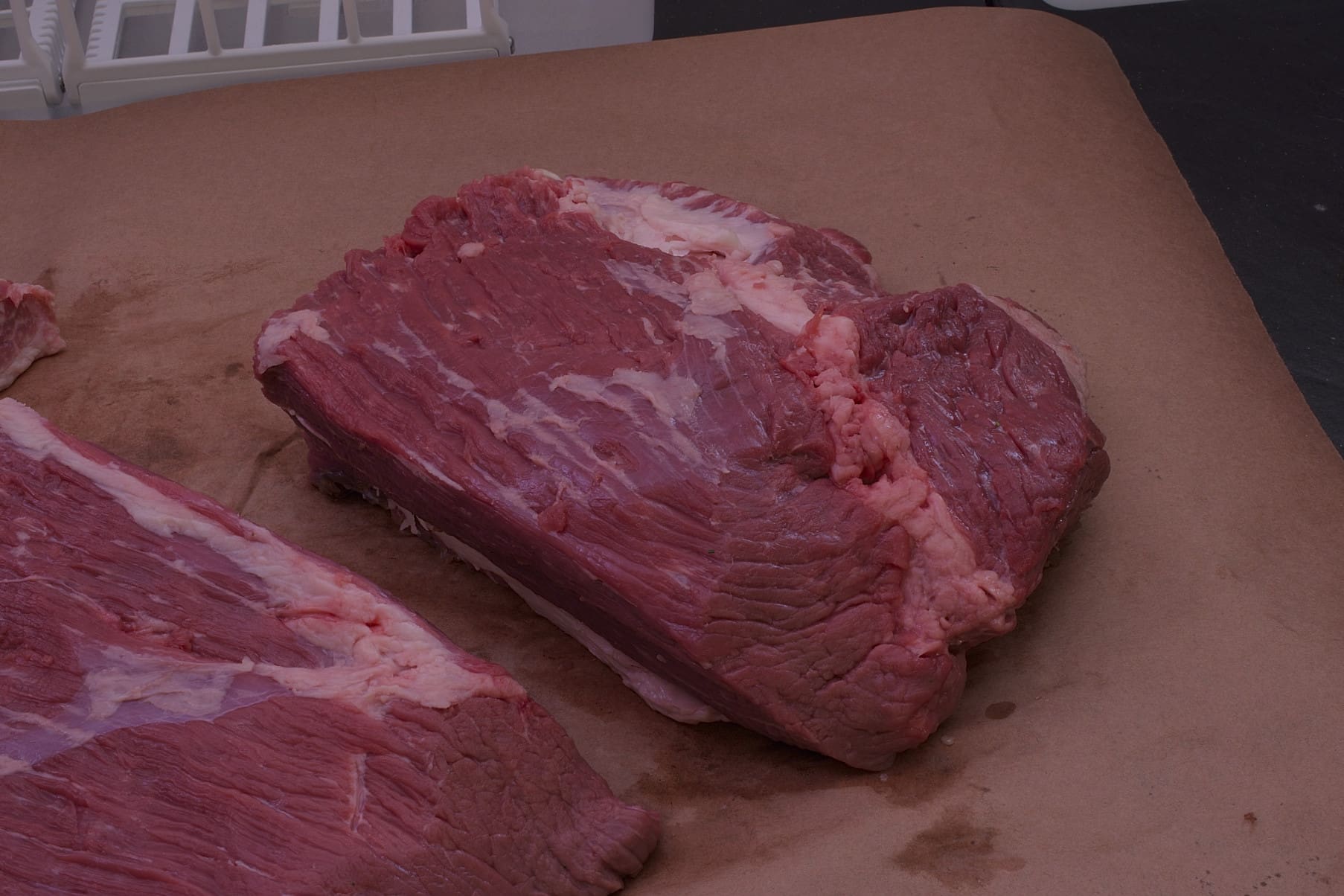
Above: a 3 lb/1.5 Kg section of the point–higher in fat and more irregularly shaped than the flat.
Serves 4-6
Level of difficulty: 2.75
Procedure:
Preheat the water in your sous vide bath to 140 F/60 C.
Processing
Vacuum seal the brisket point section in heat rated plastic bags. Process for 48 hours to pasteurize and fully tenderize. Cold shock the sealed package in iced water until it achieves 70 F/21 C. Refrigerate at 40 F/4 C. As long as the seal is not broken, the roast can remain safely refrigerated in this state for at least two weeks.
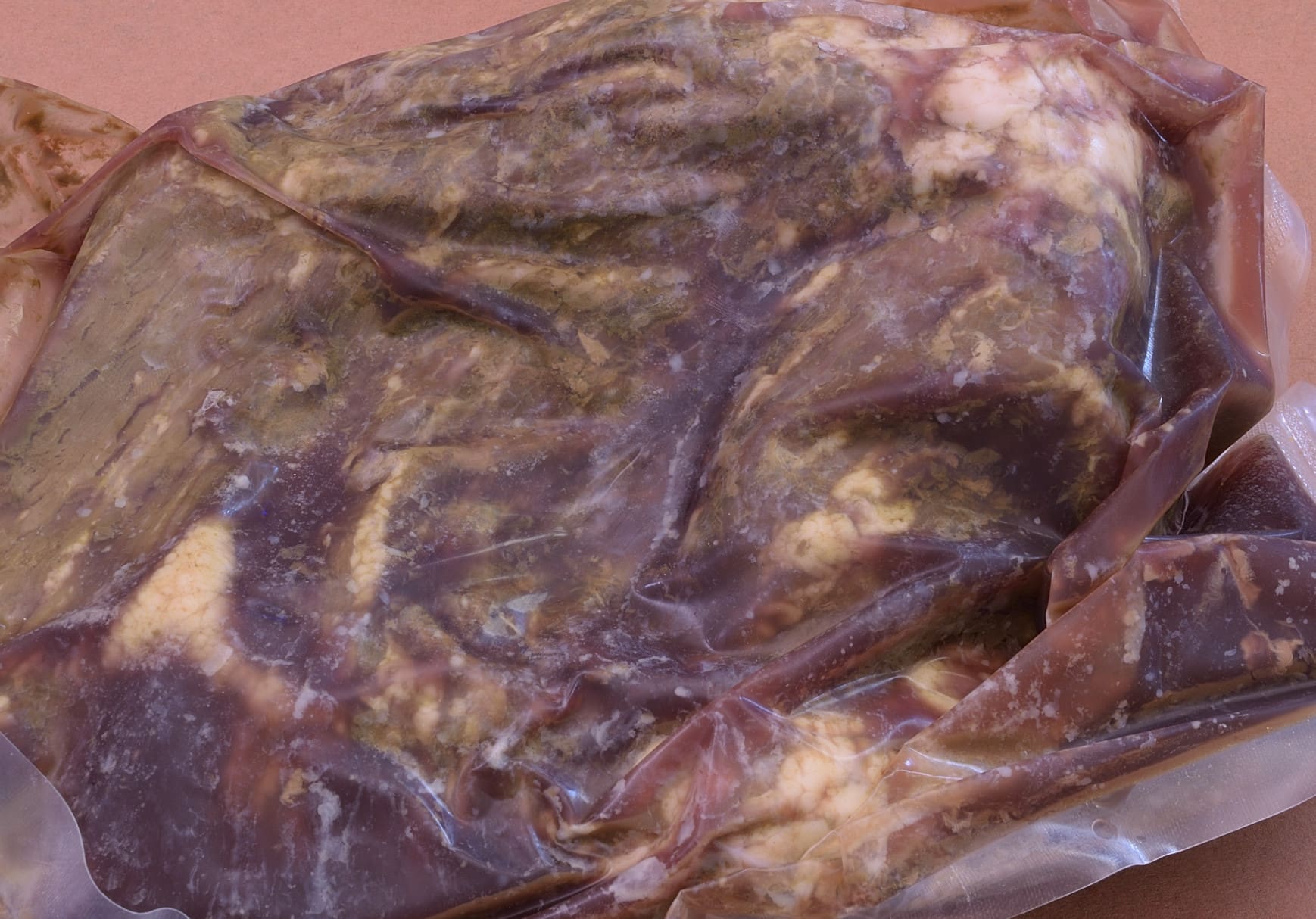
Remove the sealed package from the refrigerator. Submerge in hot tap water at 110 F/43 C (or an operating sous vide bath at any temperature) until the gel/juices melt. Remove the roast from the bag and harvest the juices into a microwaveable container (or small sauce pan). Set aside.
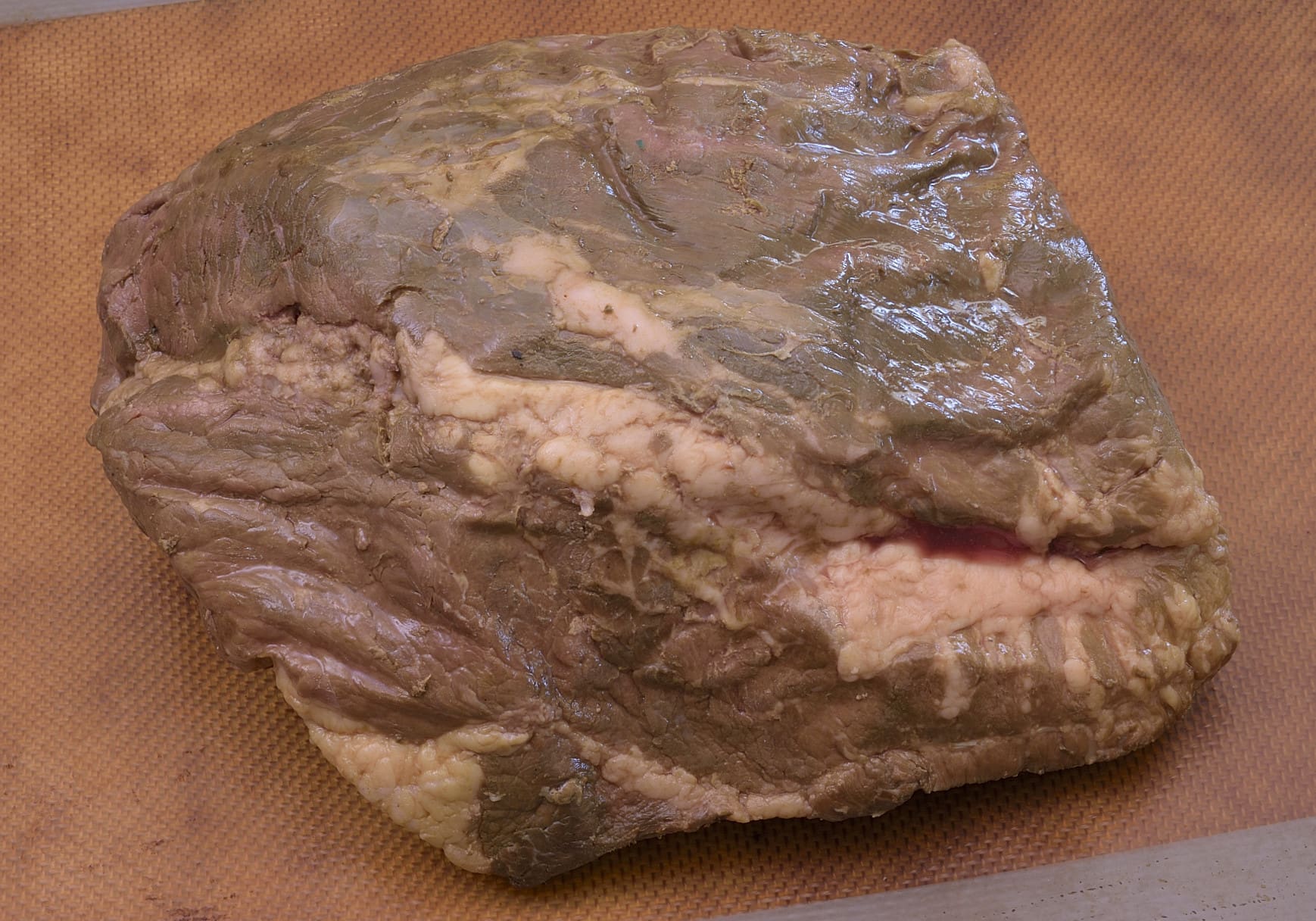
Stage the roast onto a sheet pan lined with a silicone mat or parchment. Pat dry with paper towels.
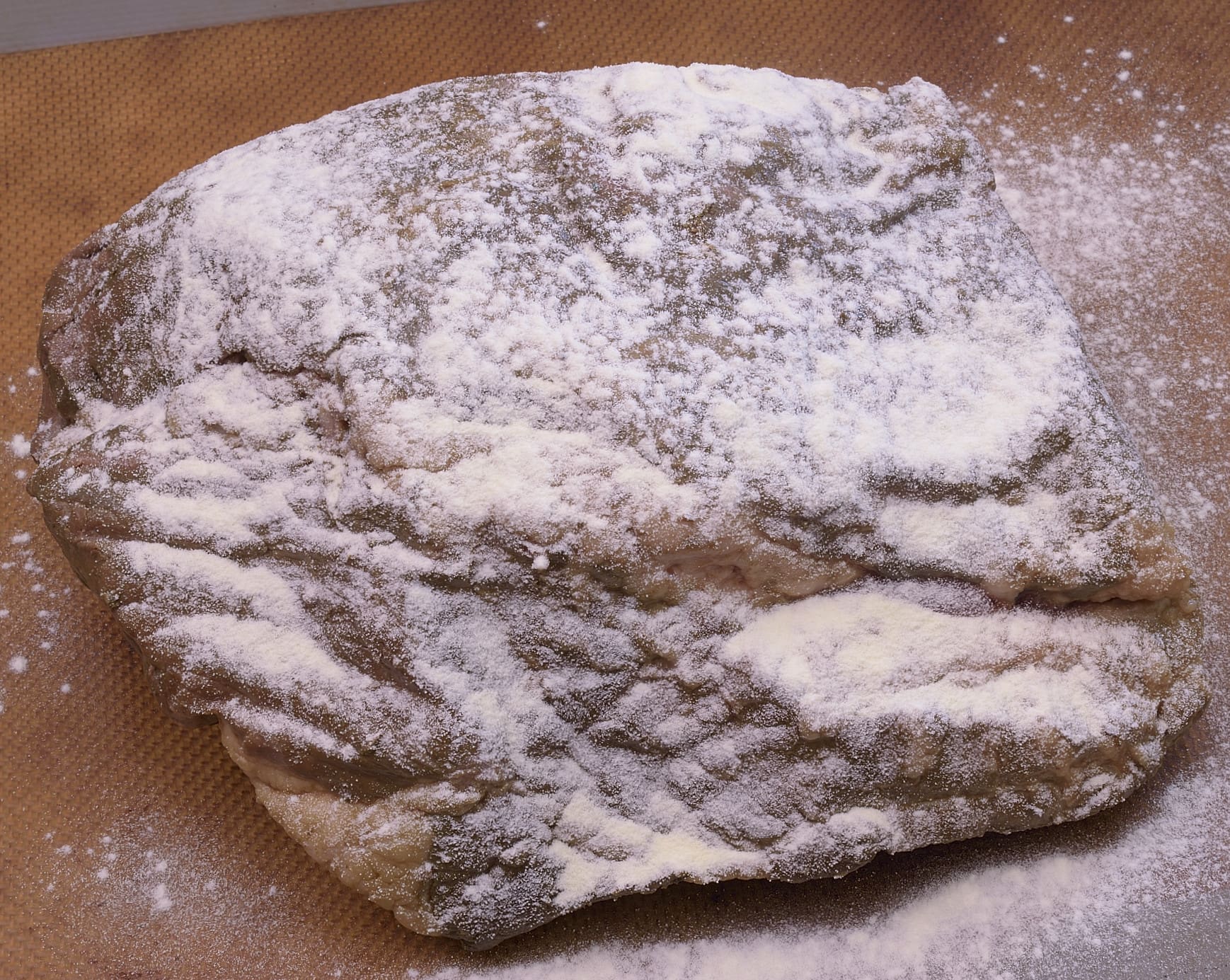
Use a dredge/shaker (or sifter) to dust with powdered egg white (or brush with well beaten liquid egg whites). This will create a sticky surface for seasonings to cling to. For people who are allergic to egg products, powdered buttermilk or even flour can be substituted. Egg whites become firm when exposed to heat, and buttermilk does NOT. Exposing a buttermilk based crust to direct heat from the surface of a pan tends to remove the coating, as opposed to securing it.
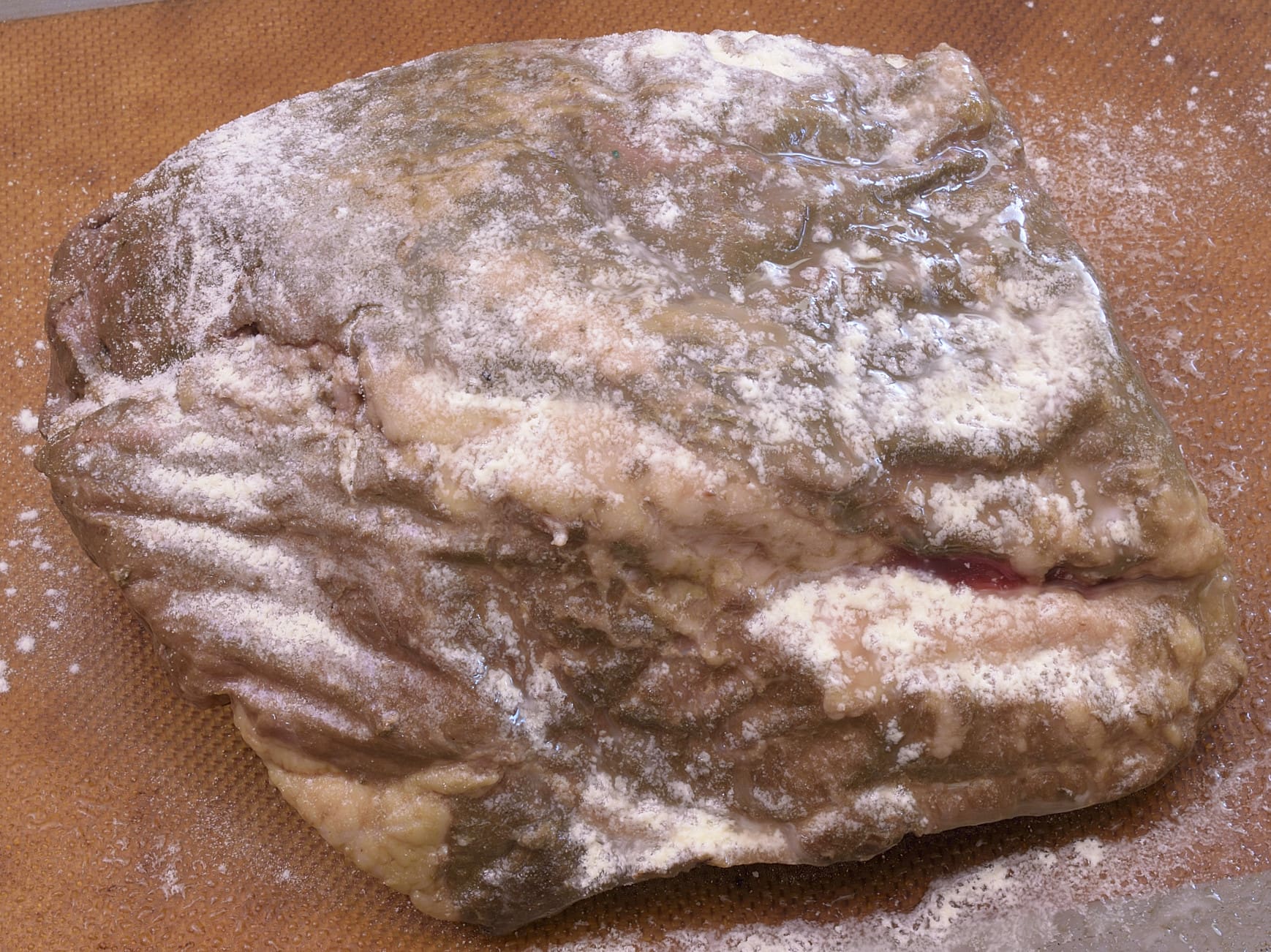
Mist the surface with a spray bottle to dissolve the egg whites.
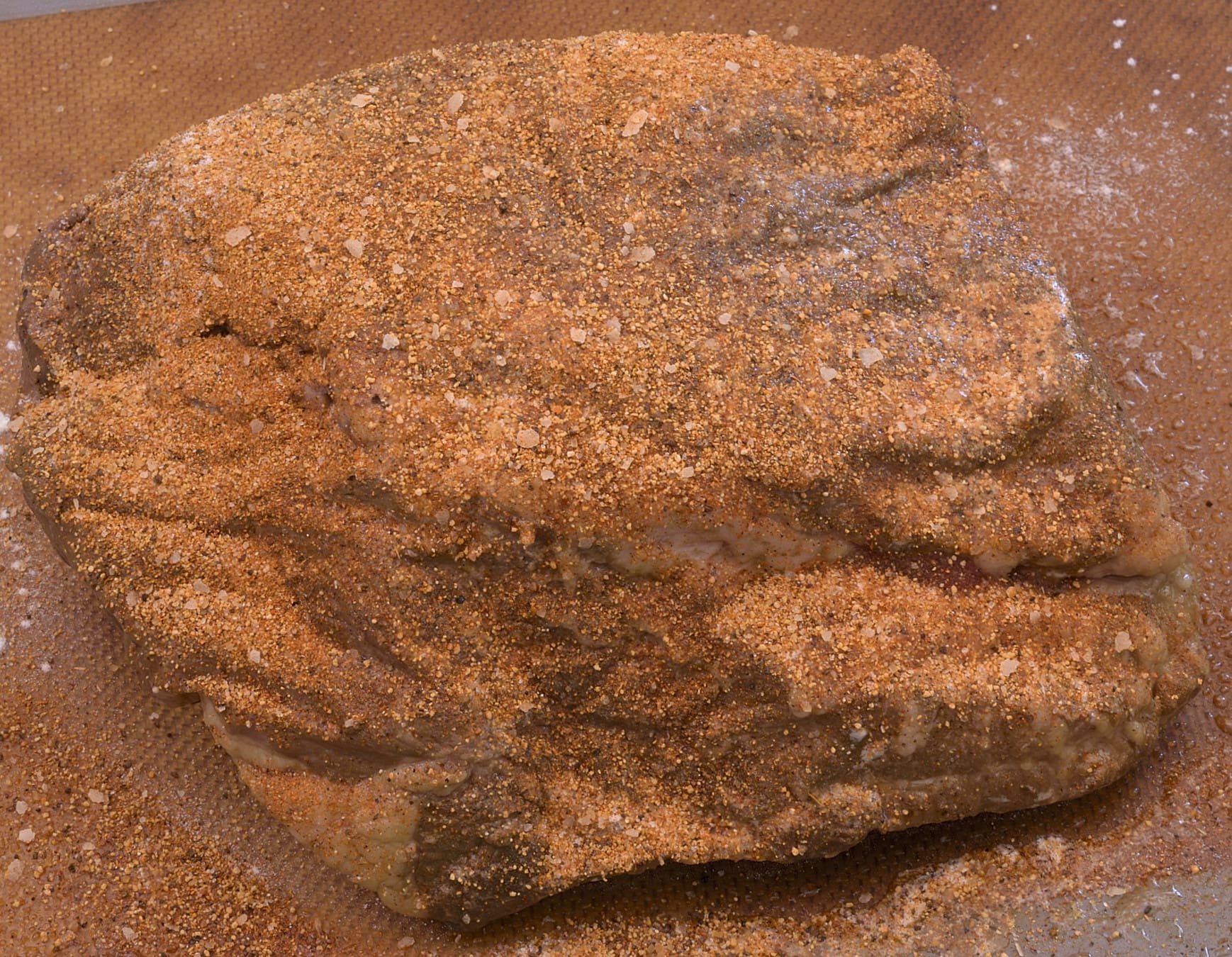
Sprinkle with your favorite rub/seasoning or use one of ours linked HERE. Turn the roast over and repeat the egg white/mist/seasoning process.
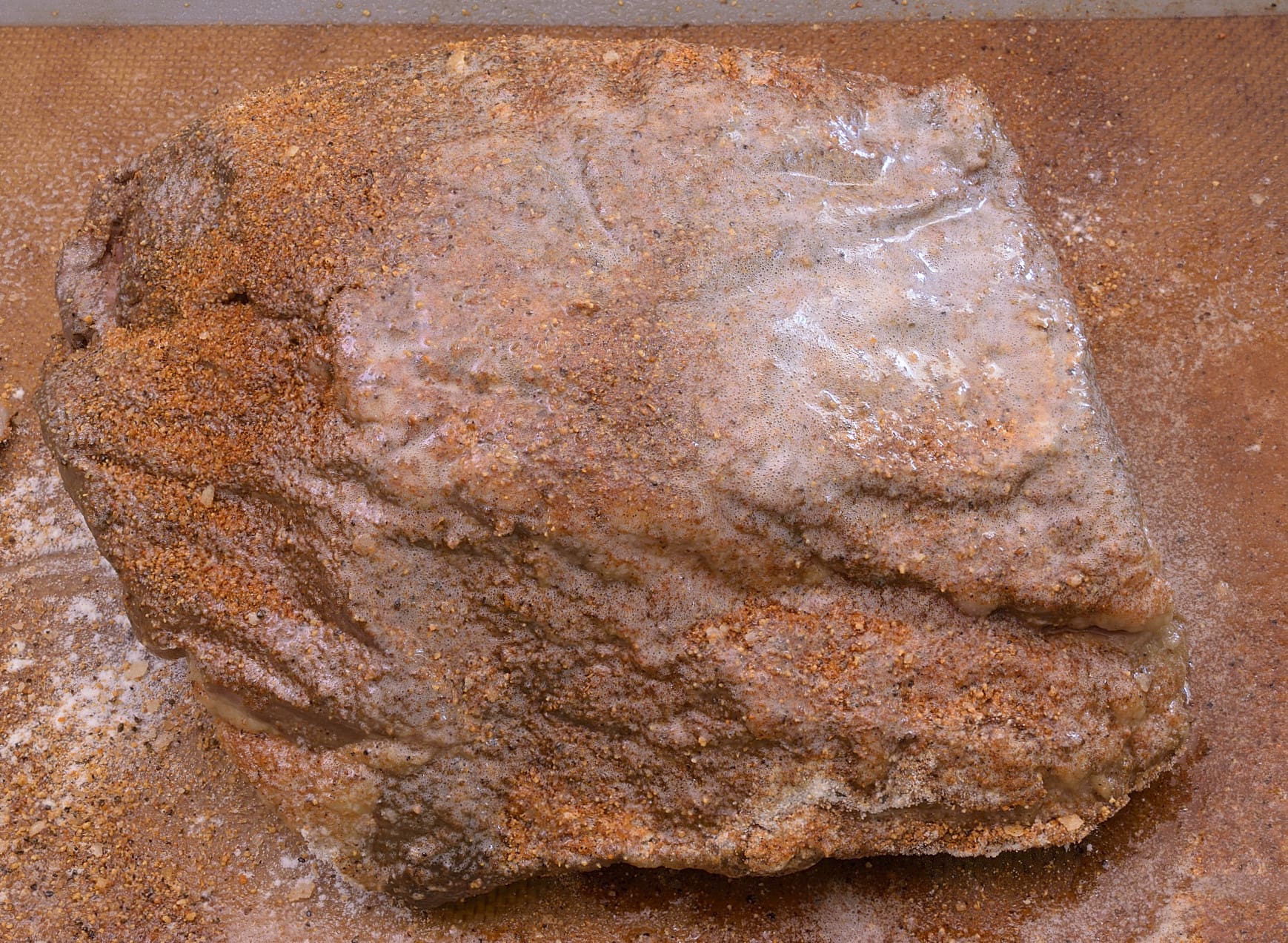
Spray or drizzle lightly with vegetable oil. Stage brisket flat into oven and roast for one hour. Turn over and roast for another hour, drizzling every 15 minutes with the basting sauce (see below).
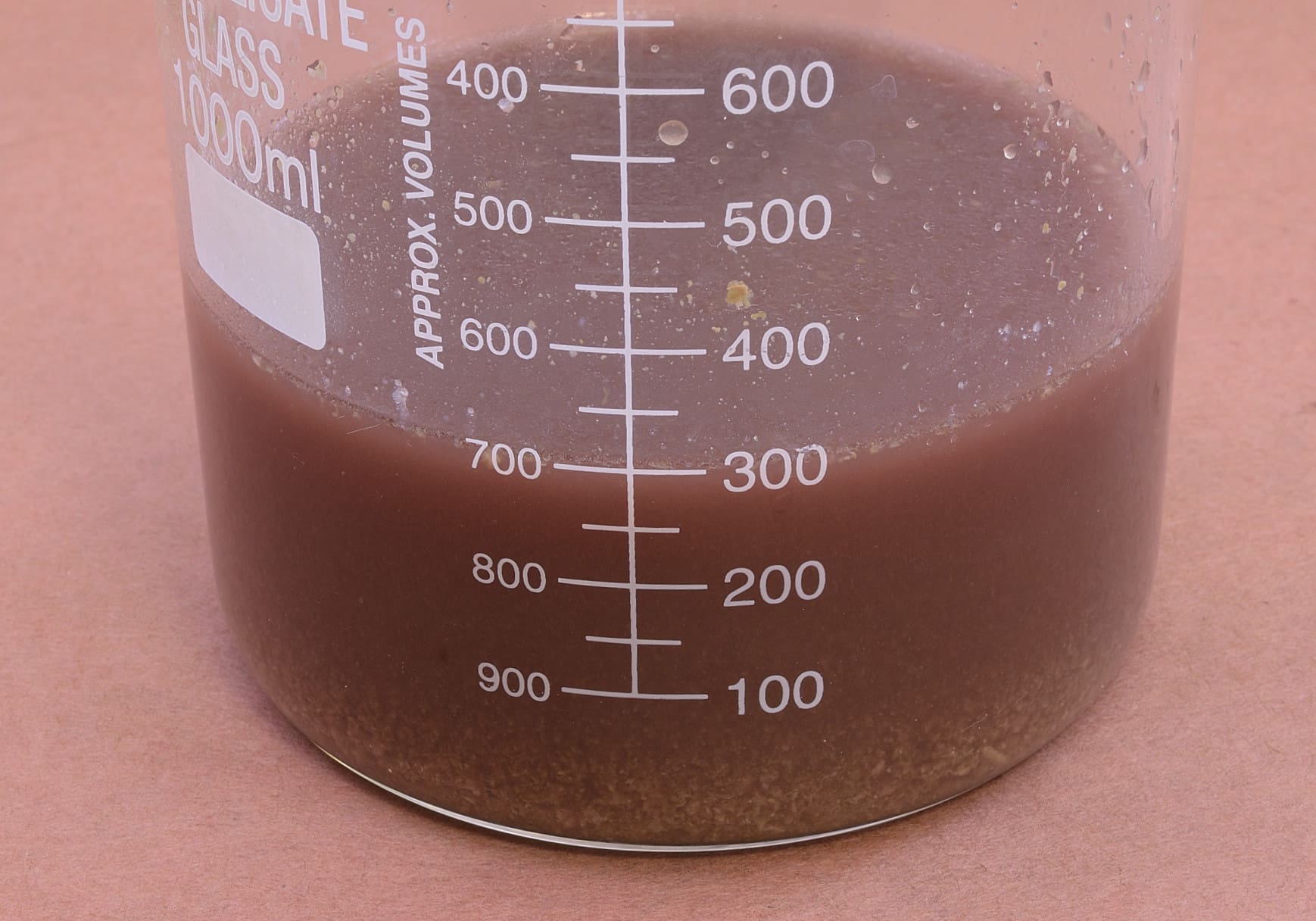
Bring the juices to a full boil–approximately 45 seconds in a microwave oven. Take care to not allow the liquid to boil over. Place a small colander or kitchen strainer above a container and line with moistened paper towels.
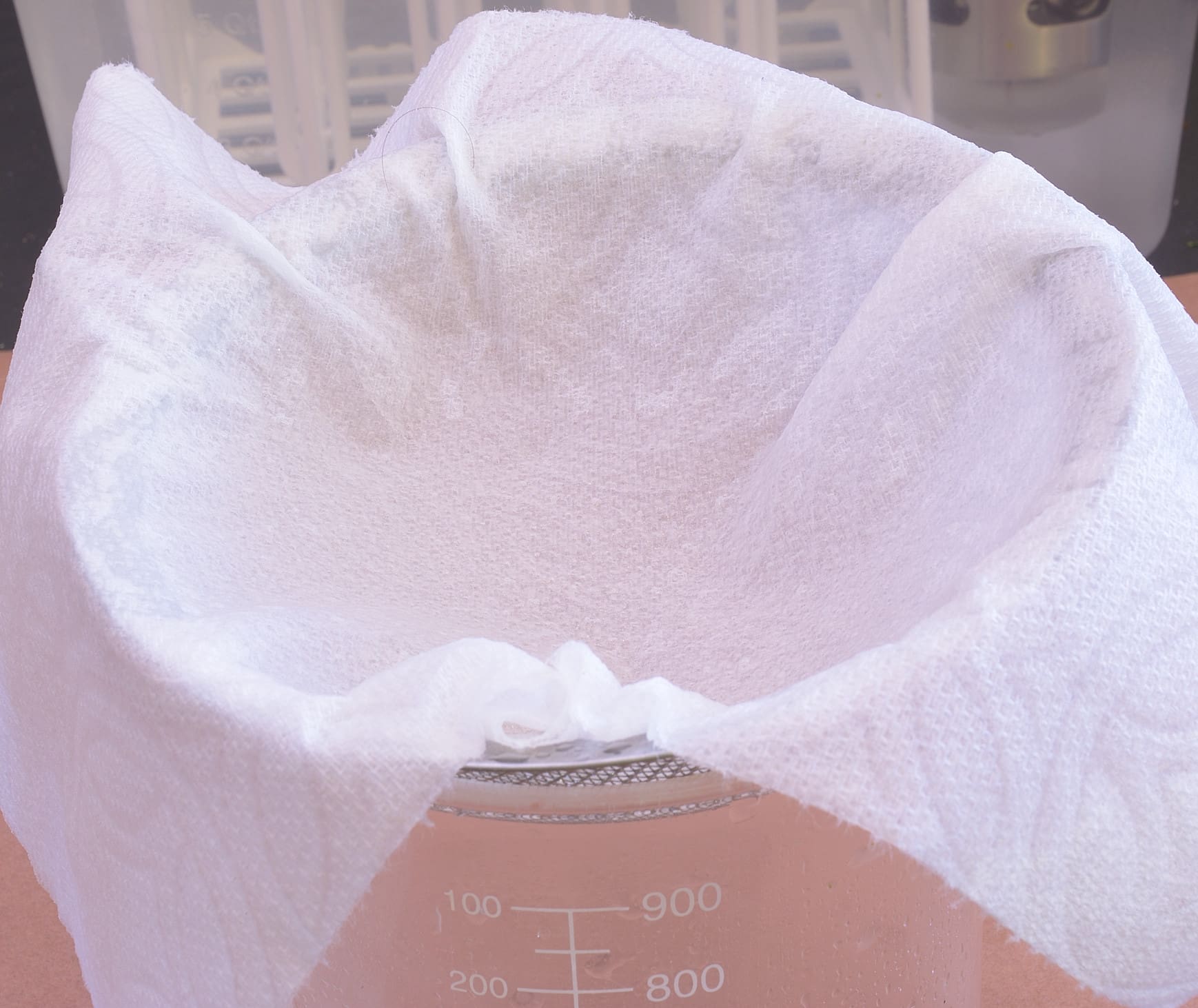
Moistening the paper towels prevents the juices from clinging to the fabric.
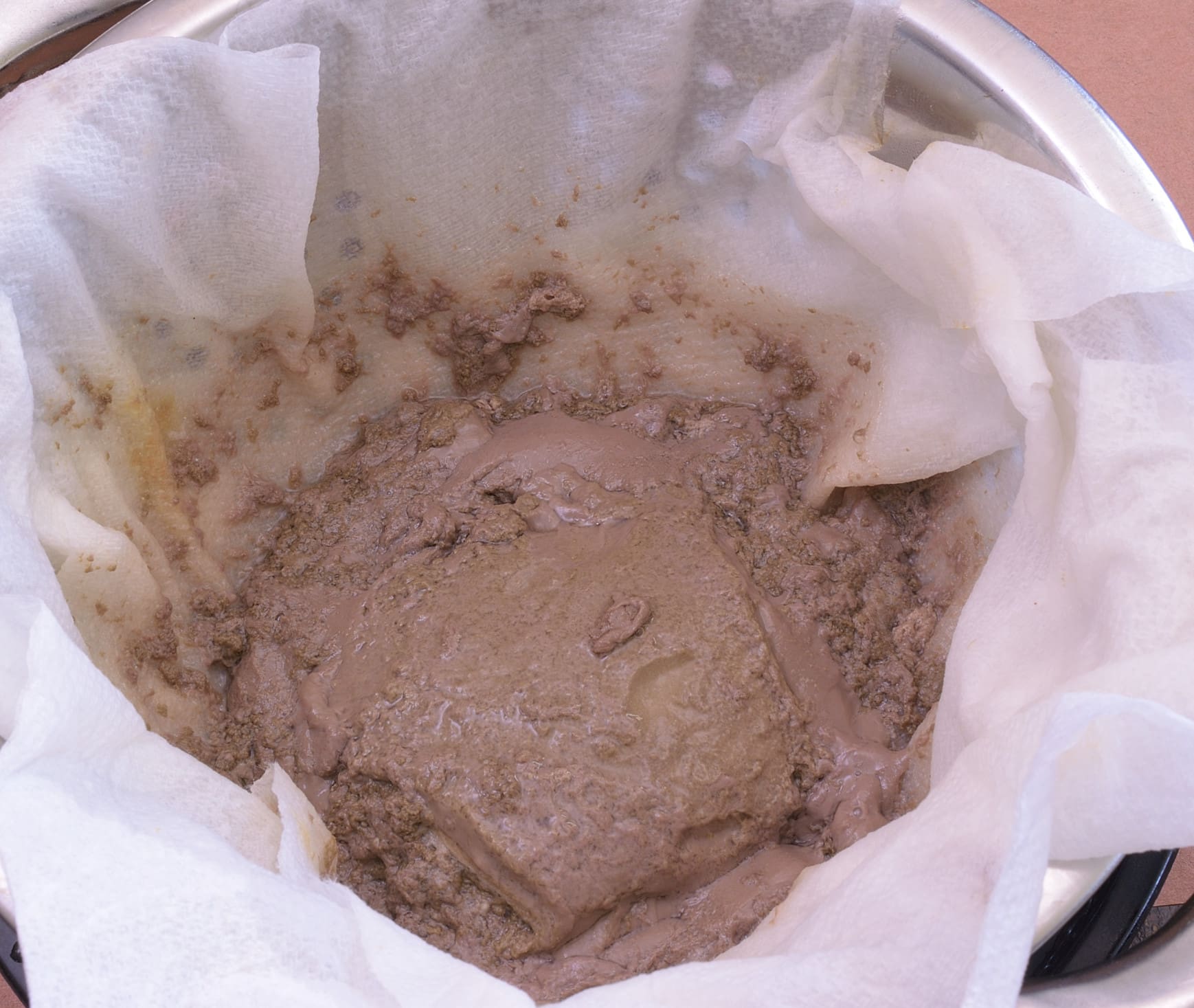
Pour the juices into the moistened paper towels. The fabric will capture the denatured myoglobin and albumins, which can have an “off,” sulfurous aroma and flavor. Discard the paper towels and their contents.
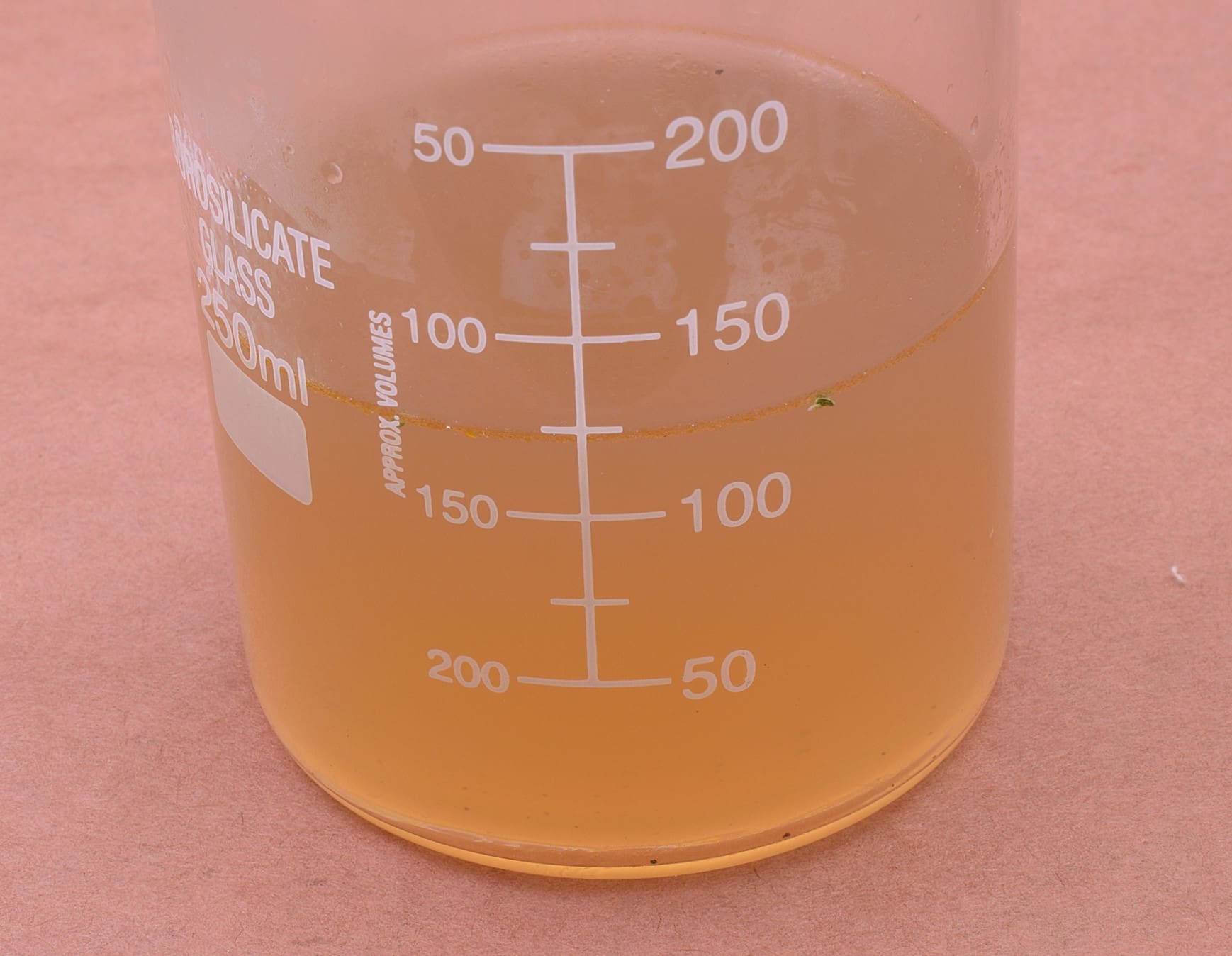
The resultant liquid is the equivalent of a clarified, heavily reduced consommé and will be rich in flavor. Combine the consommé half and half with your barbecue sauce of choice to make a light basting sauce.
Caution: if salt is introduced into the pouch with the protein before processing, this liquid may be quite salty. Salt penetrates the surface of land/air dwelling proteins at the rate of 1″/3-4 days. This natural “curing” process causes chemical reactions that change the flavor and texture of proteins, as in the case of corned beef and ham. In sous vide, even with extended marination, there will be a lot more salt in the juices than there will be in the meat.
Preheat oven (or smoker) to 350 F/176 C.
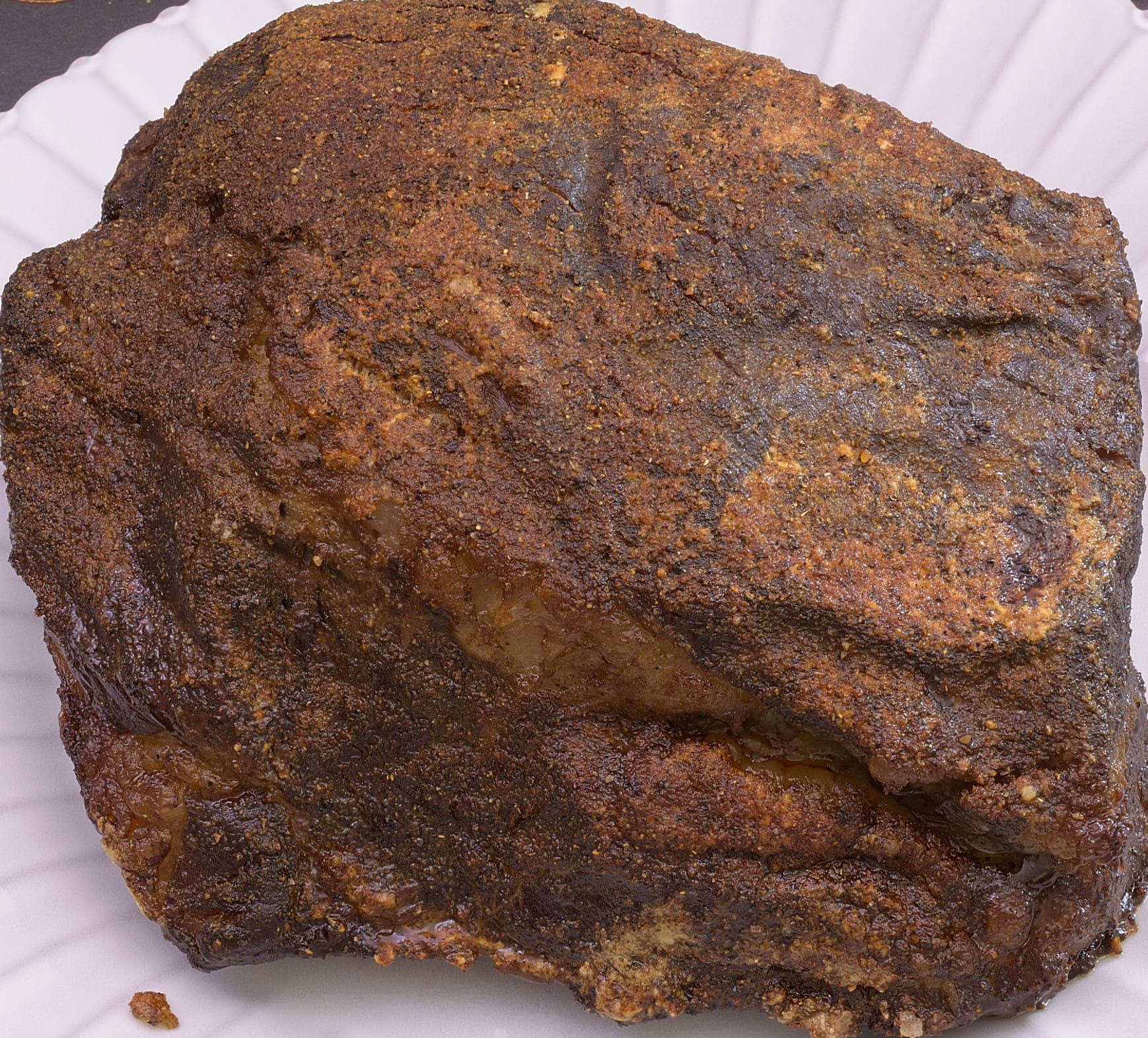
Stage the seasoned roast into the oven/smoker. Remove from the oven when the internal temperature reaches at least 130 F/54 C–this is generally considered to be “mouth hot.”

The “point” is the section to the lower right, with the unique, “cellular” grain. The extended section of the flat is above. Brisket aficionados become accustomed to navigating the ample amount of fatty tissue, just as rib eye lovers learn to appreciate a wee bit of gristle. No soybeans or quinoa here.
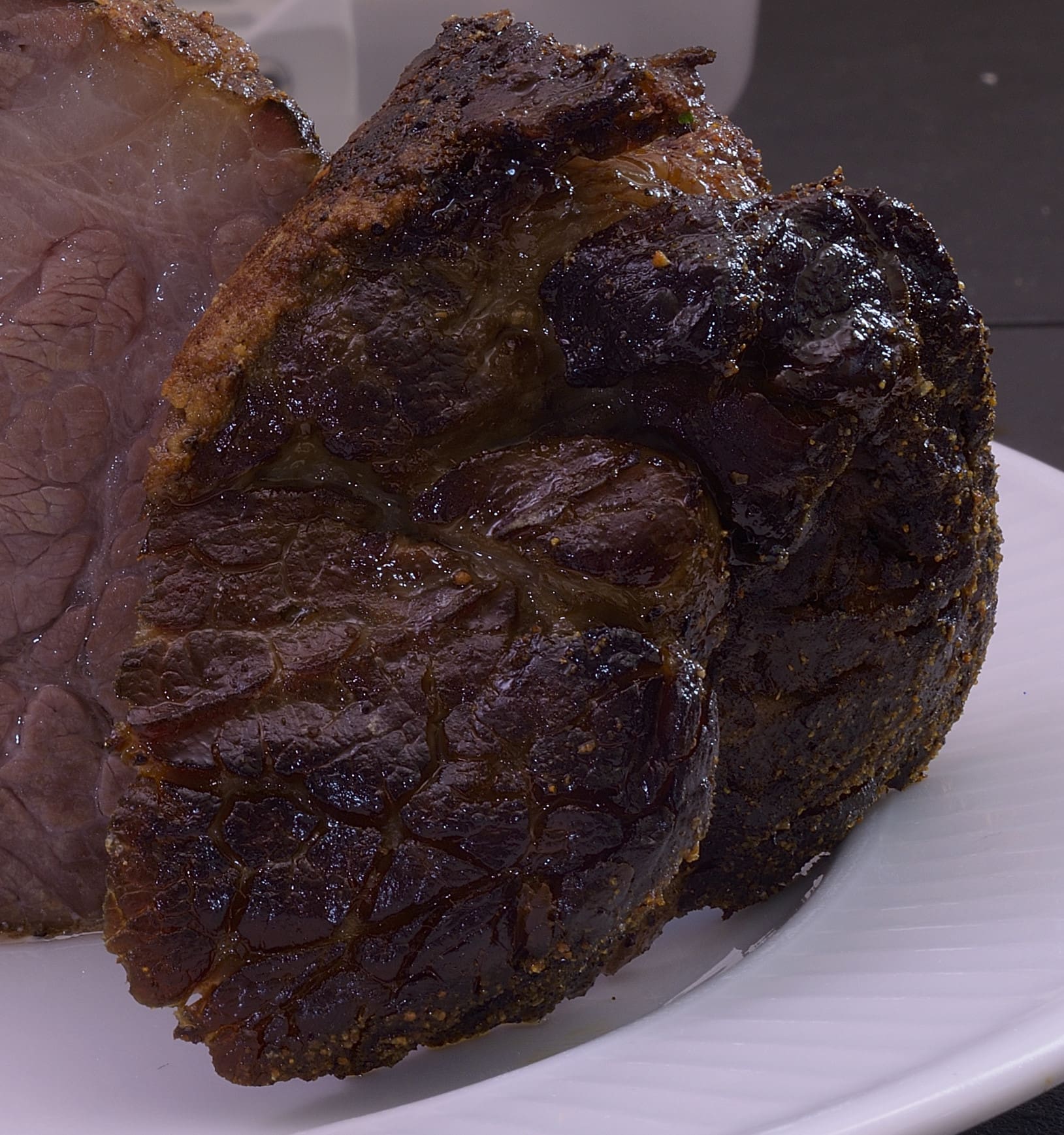
Service
There is more than one suitable options for this flavorful section of the brisket. First, a simple, “traditional” presentation.

Cornbread, grilled. Hey, I said it was simple! BBQ sauce not pictured.
Adaptation: “Pizzaiola-ish”
Defining the term “Pizzaiola” is fraught with risk and controversy. We needn’t provide fuel to the fiery debate as to which version is the authentic one.
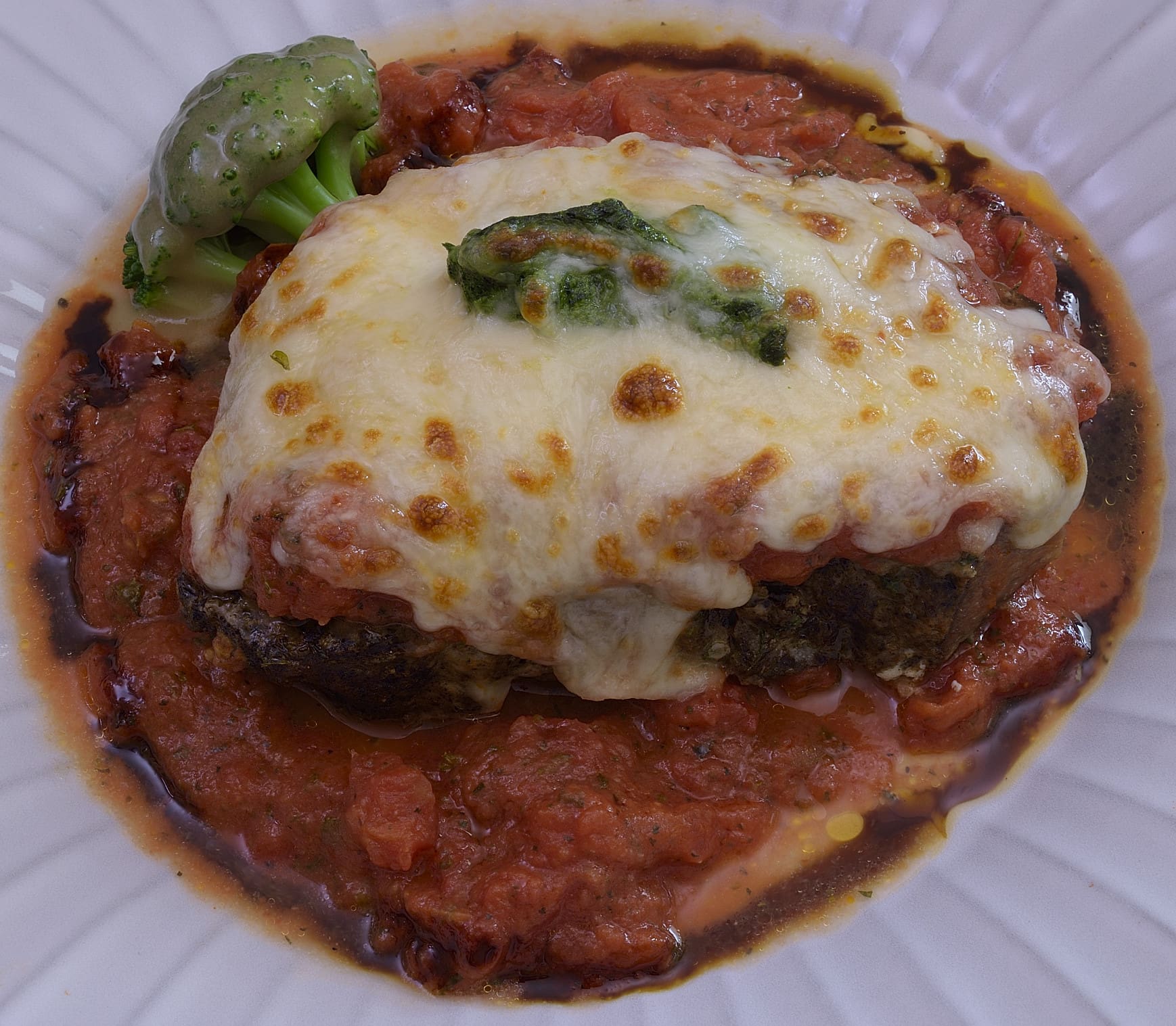
We will note that this dish bears some resemblance to a few of the myriad versions of an old fashioned Italian dish. Suffice it to say that the dish consists of “braised” beef with a rustic style tomato sauce, mozzarella and Reggiano cheeses, and even a little spinach flavored mascarpone.
The sauce
I used well drained, canned San Marzano tomatoes to make a chunky tomato sauce briefly cooked with oregano, basil, garlic, parsley, salt, pepper, dried parsley and a pat of butter to finish. Your Nonna’s version or one from the market shelf is perfectly suitable. I spend most of my day in the kitchen but I know that most people don’t. There is no shame in opening a jar now and then. Aged or fresh mozzarella, totally up to you!
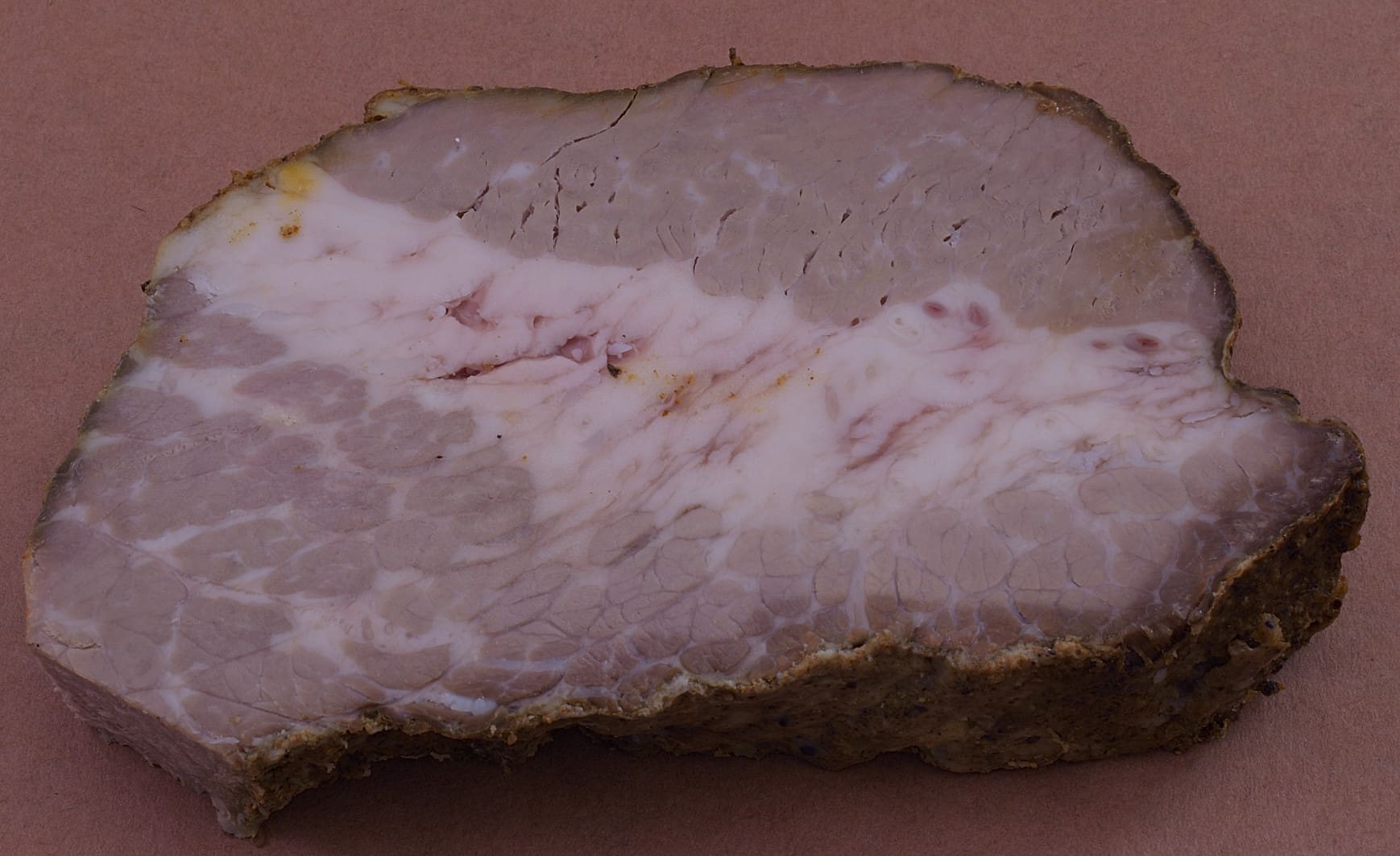
A 6 oz/175 g steak cut from the point end reveals that both muscles are evident. The layer of fat is clearly visible–we will use a slow-searing process to remove as much of that fat as possible.
Disclaimer: we offer no assurances that this dish belongs on any diet regimen designed to help you lose weight. Jenny Craig and Oprah needn’t fear our encroachment into their fitness-for-profit model.
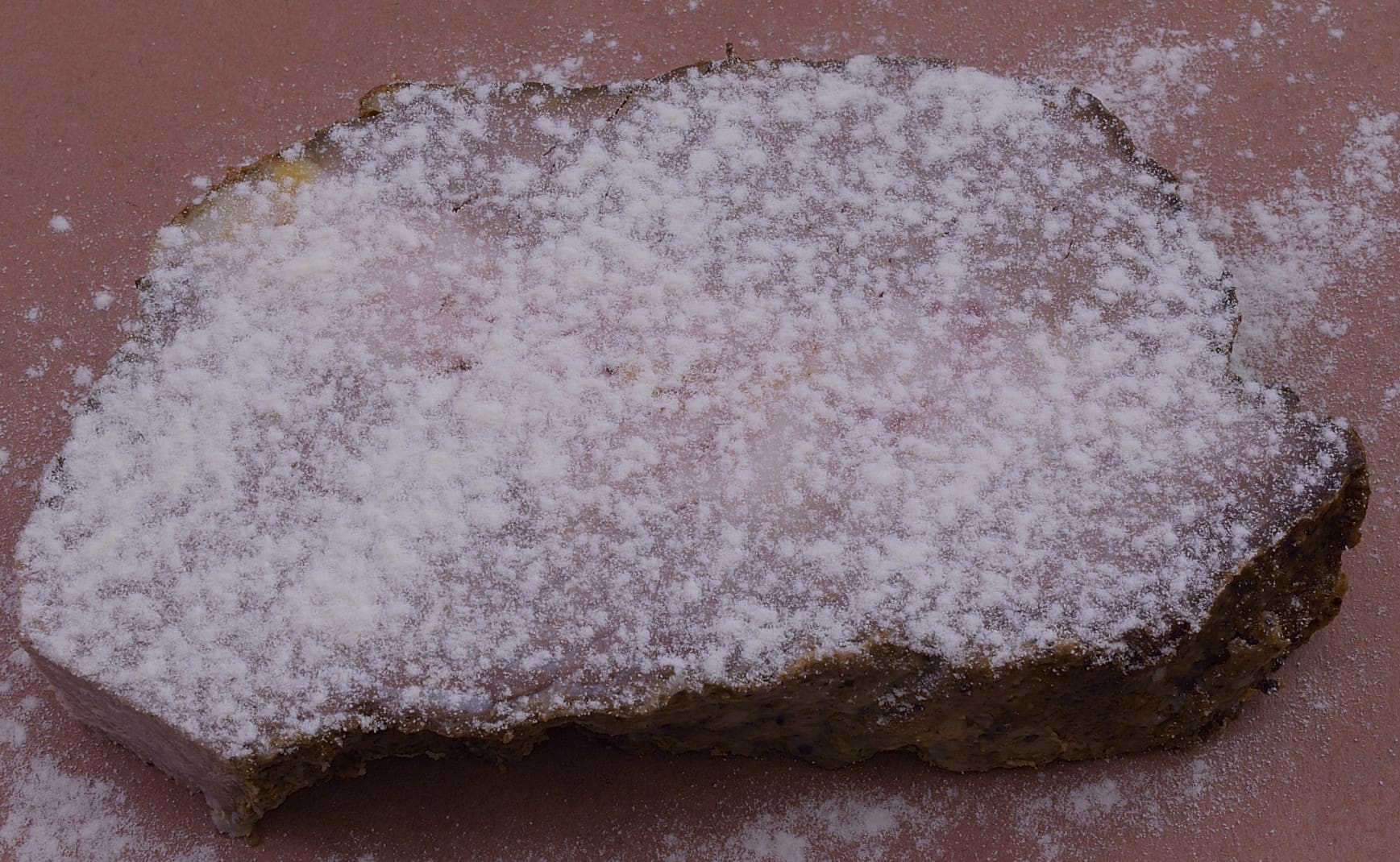
Dust lightly with powdered egg white. This creates a sticky surface so that our seasonings will cling just as it did on the original roast.
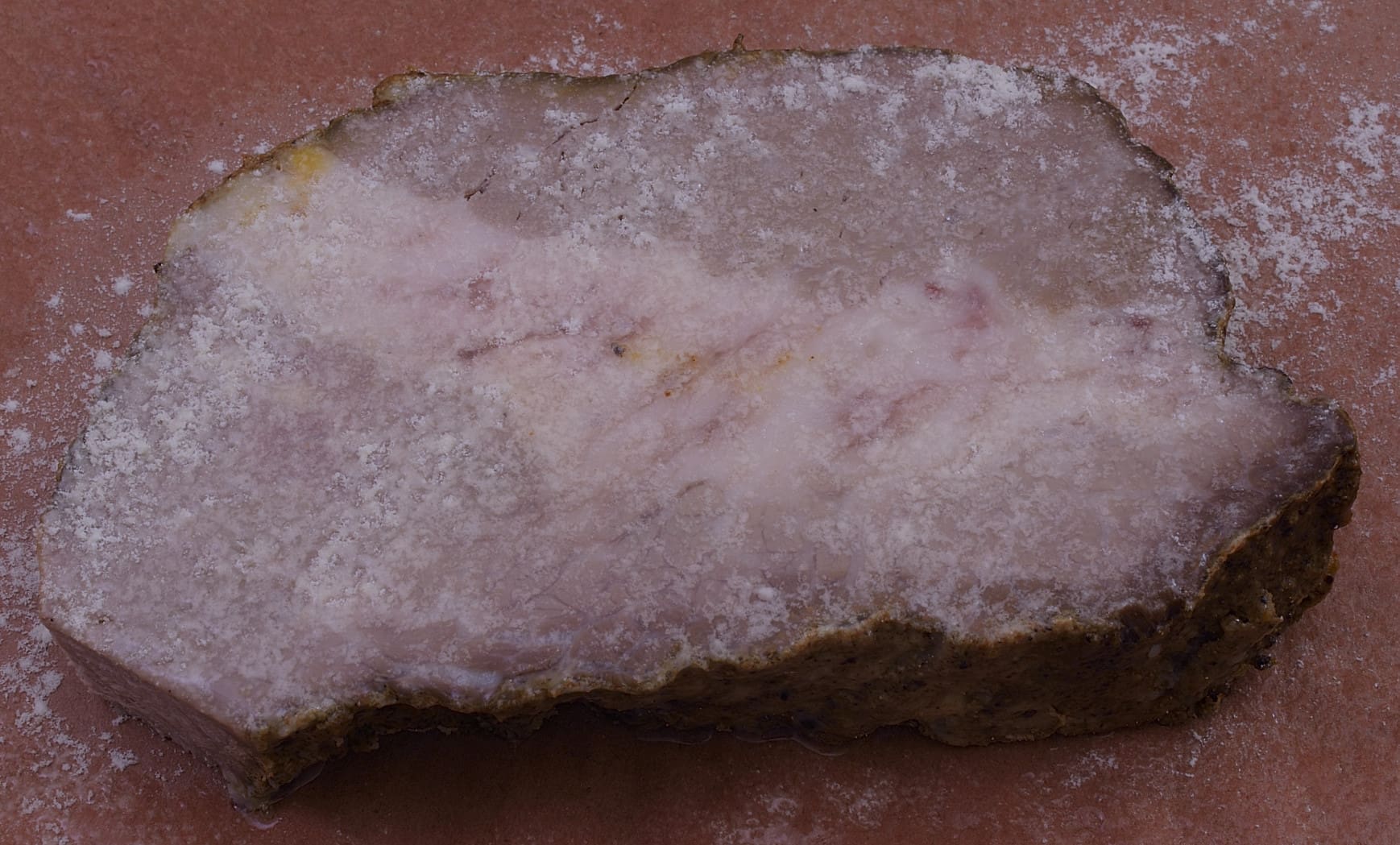
Use the spray bottle to moisten the egg whites (not necessary if you use well beaten fresh egg whites), just as we did before.
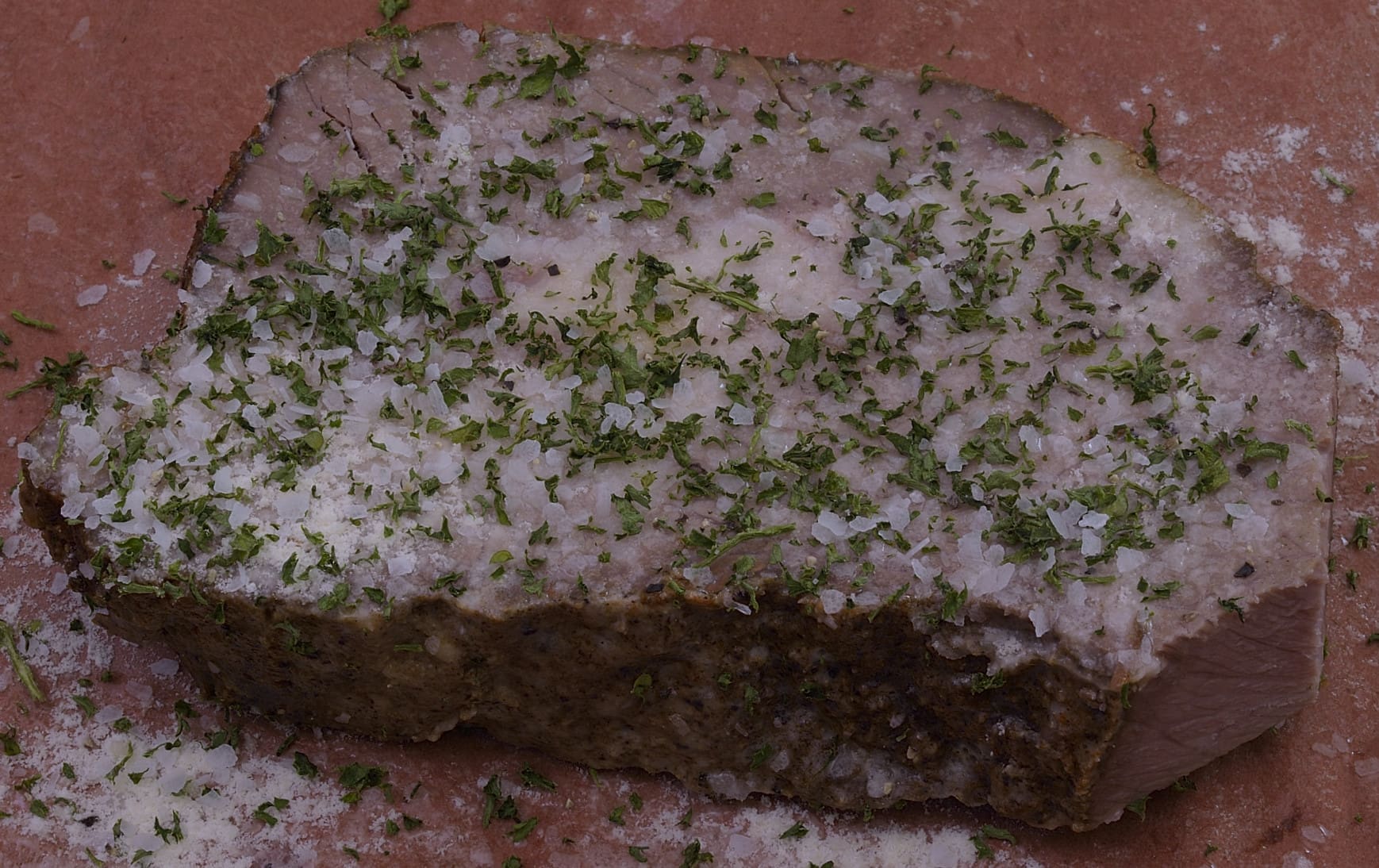
Sprinkle with your favorite seasonings. In the picture, kosher salt, white pepper, and home dried parsley. Turn the steak over and repeat the process.
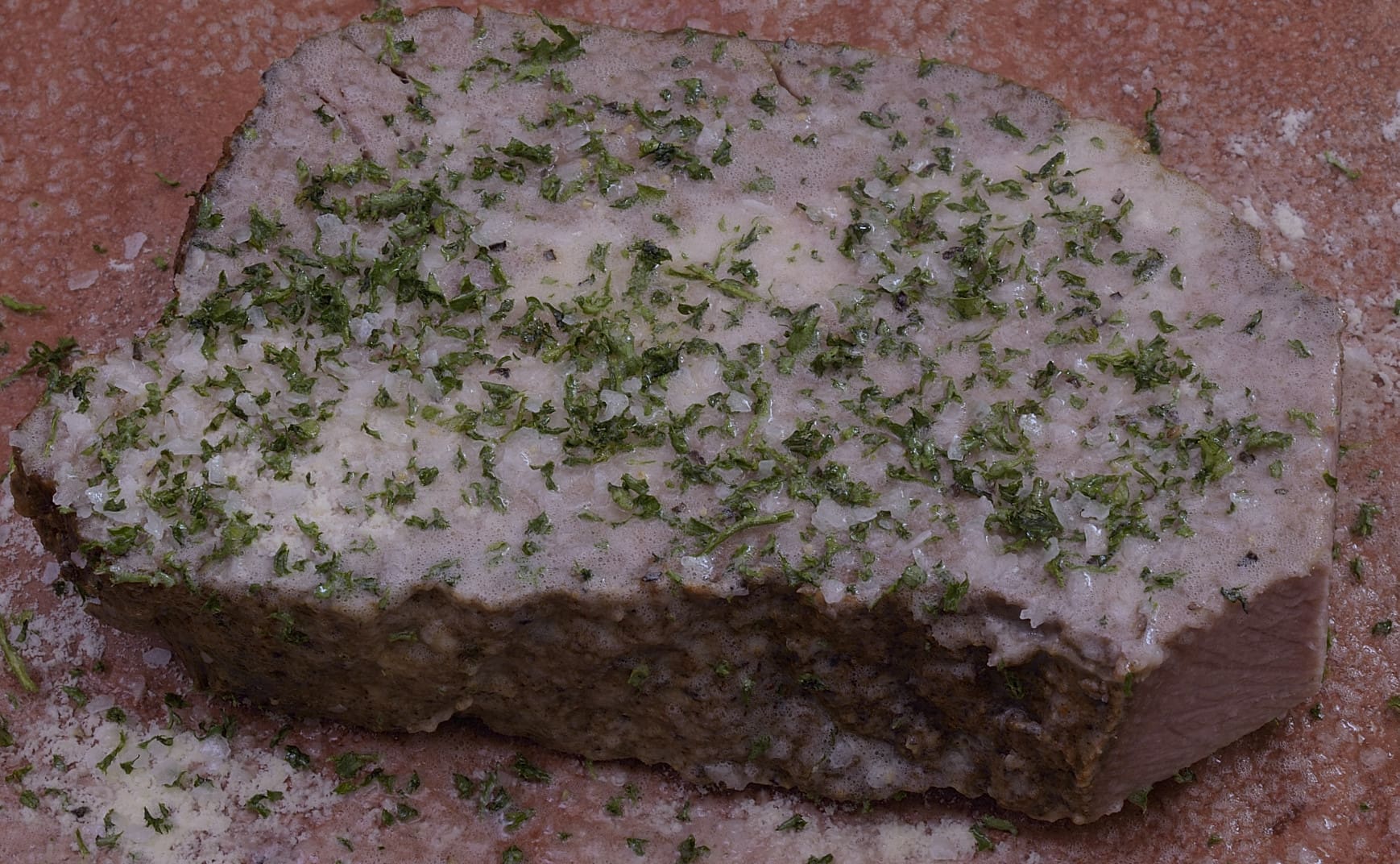
Spray (or drizzle) lightly with oil–this discourages sticking to the pan and encourages the uniform transfer of heat. While we wait for the seasonings to set, preheat a cast iron or thick bottomed skillet to 300 F/150 C.
Place the cold steak in the hot pan. I recommend using a bacon/steak press to encourage evenly dark marks on the steak. You should hear sizzling but not popping. This is the best way to remove as much internal fat as possible–patiently sear well on both sides and keep warm. You should notice some fat having drained into the pan, an encouraging sign.
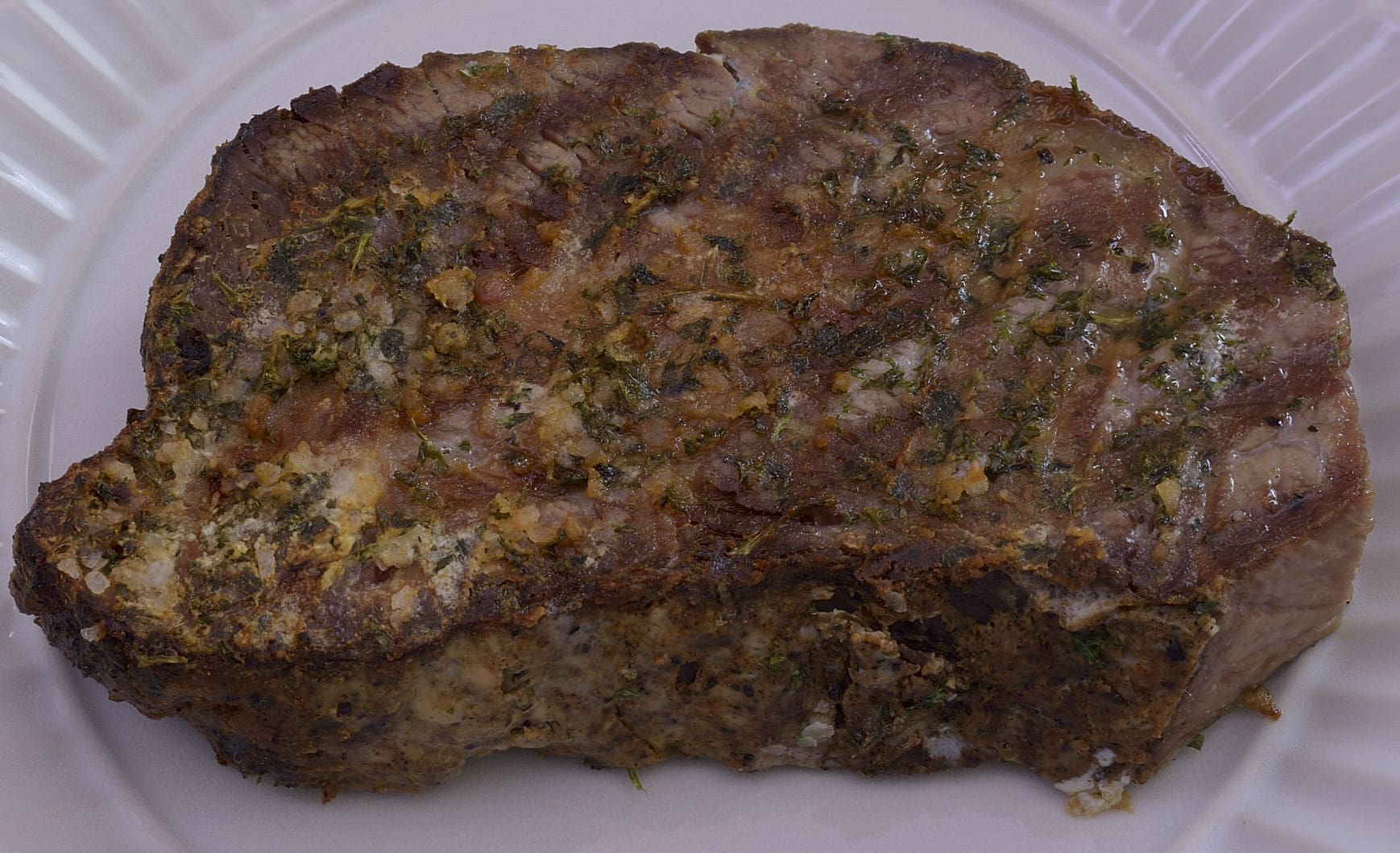
Set the oven on the “broil” function (or 450 F/232 C).
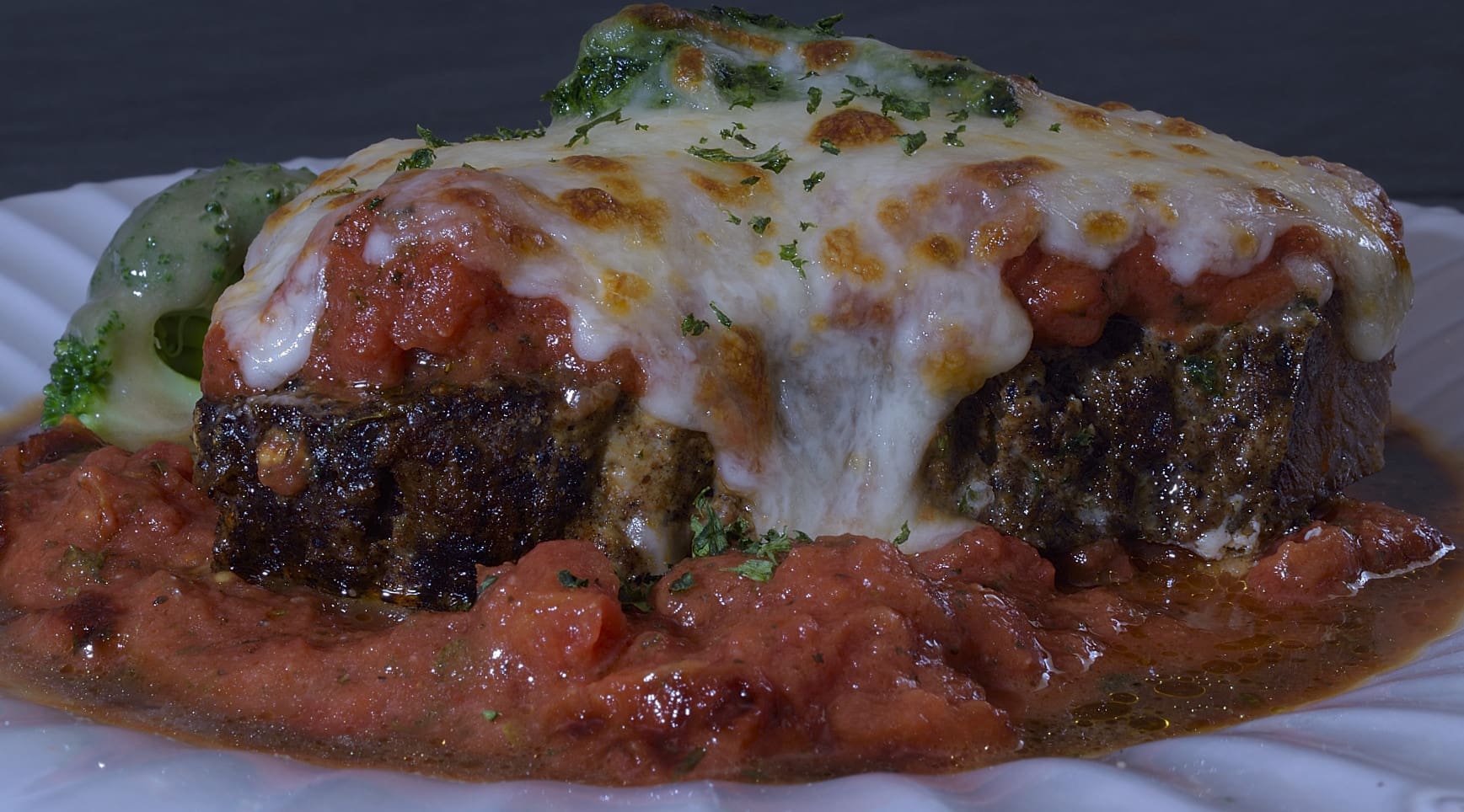
Put some sauce on a heat proof plate (or pan) and lay the steak on top of it. Put some more tomato sauce on the steak–this is a tomato heavy dish. Top with mozzarella cheese. Broil or bake until the cheese melts and you get the desired visual effect.

Sprinkle with a few shards of Reggiano. A little well drained cooked spinach blended with mascarpone (or cream cheese) adds colorful vibrancy, again, optional.
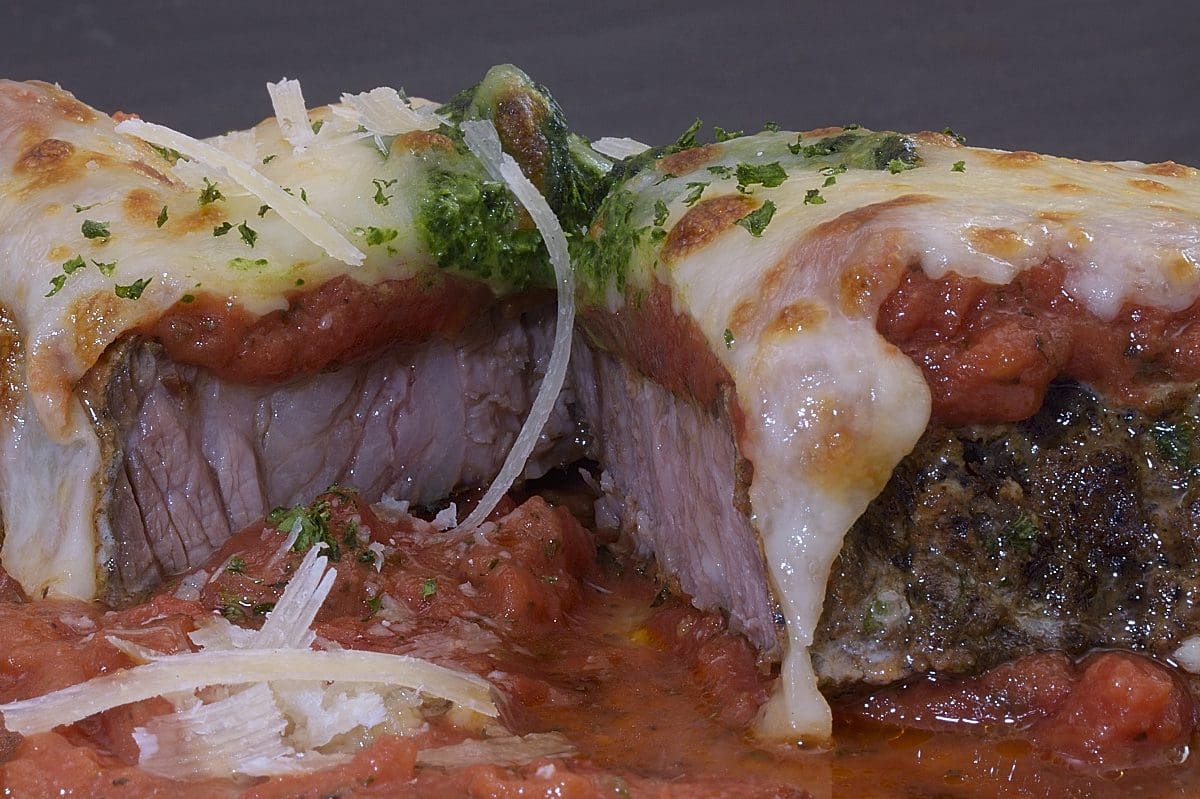
1
1